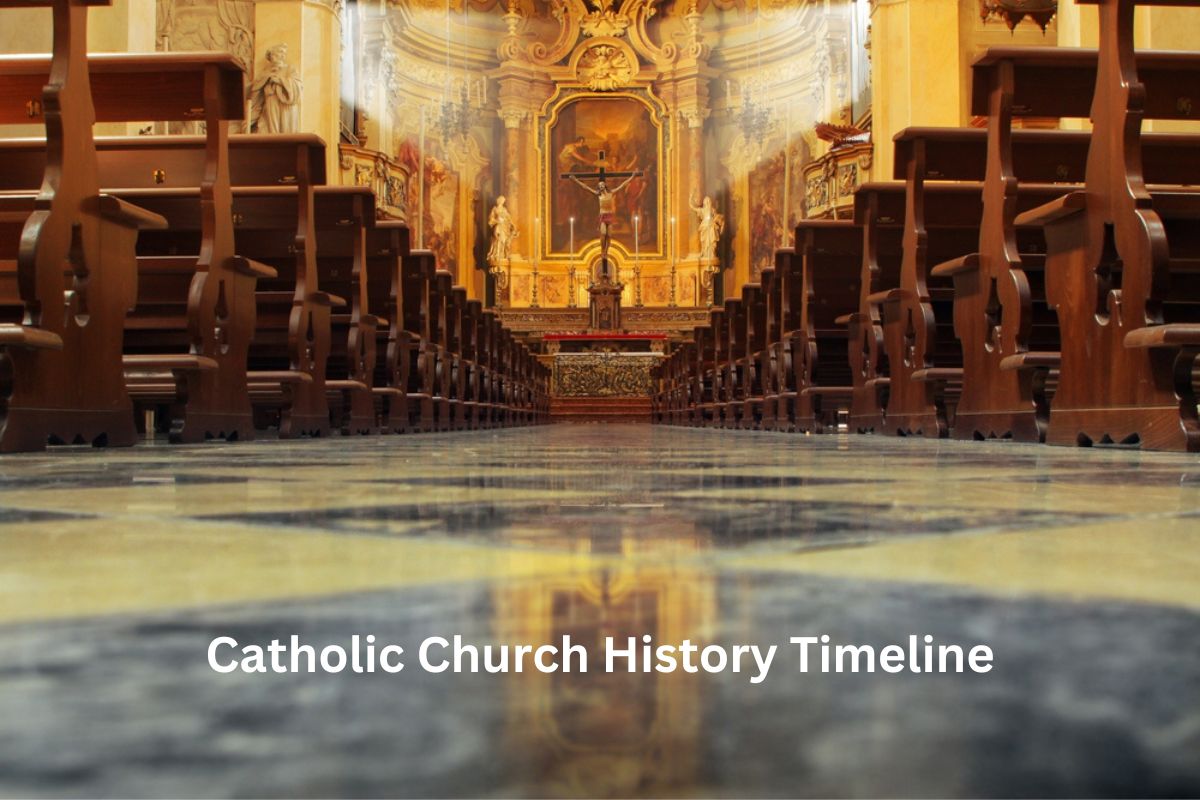The history of the Catholic Church is a rich and intricate tapestry woven over two millennia, encompassing a multitude of events, figures, and developments that have left an indelible mark on both the religious and secular history of the world.
This Catholic Church History Timeline provides a concise overview of key moments and milestones in the evolution of the Church, from its earliest days in the 1st century AD to the complex challenges and transformations of the 21st century.
It explores the Church’s theological development, its interactions with political powers, its responses to social and cultural shifts, and its enduring commitment to faith, charity, and the teachings of Jesus Christ.
As you journey through this timeline, you’ll gain insights into the profound and often tumultuous history of the Catholic Church, a story that continues to shape the lives of millions of faithful believers worldwide.
| Century | Key Events |
|---|---|
| 1st Century AD | c. 30-33 AD: The crucifixion and resurrection of Jesus Christ. c. 33-64 AD: The early Christian community begins to form. |
| 2nd-3rd Centuries | Development of Christian theology and emergence of early Christian texts. Persecutions of Christians under Roman emperors. |
| 4th Century | 313 AD: The Edict of Milan, issued by Emperor Constantine, grants religious tolerance to Christians. 325 AD: The First Council of Nicaea establishes key Christian doctrines, including the Nicene Creed. |
| 5th-7th Centuries | Expansion of Christianity in Europe, including the conversion of various European tribes. Development of monasticism. |
| 8th-11th Centuries | 800 AD: Charlemagne is crowned Holy Roman Emperor by Pope Leo III. Schism between the Eastern Orthodox Church and the Roman Catholic Church (1054). |
| 12th-13th Centuries | Height of the Middle Ages with the construction of many cathedrals. Founding of various religious orders, including the Franciscans and Dominicans. 1215 AD: The Fourth Lateran Council addresses various Church reforms. |
| 14th-16th Centuries | 14th-century papal schism (1378-1417) with multiple claimants to the papacy. 16th-century Protestant Reformation begins with Martin Luther (1517). 1545-1563: The Council of Trent, a key response to the Reformation. |
| 17th-18th Centuries | Expansion of Catholicism through missionary work. Enlightenment challenges the Church’s influence in some European countries. |
| 19th-20th Centuries | 19th-century papal states are dissolved, leading to the Vatican City’s creation. 20th-century Church involvement in social issues and Vatican II (1962-1965) modernizing the Church. Challenges and scandals, including sexual abuse cases. |
| 21st Century (Up to 2021) | The papacies of John Paul II, Benedict XVI, and Francis. Continuing discussions on social issues, including contraception, women’s ordination, and same-sex marriage. Challenges and scandals, including sexual abuse cases. |
Timeline of the Catholic Church
1st Century AD:
c. 30-33 AD:
This period is marked by the crucifixion and resurrection of Jesus Christ, the central figure of Christianity. Jesus’ teachings and ministry form the foundation of the Christian faith.
c. 33-64 AD:
After Jesus’ death and resurrection, his disciples and followers began to form the early Christian community. They spread his teachings, emphasizing love, forgiveness, and the belief in Jesus as the Messiah and Son of God.
Also Read: Timeline of the Prophets in the Old Testament
This early community faced challenges and persecution from both Jewish authorities and the Roman Empire.
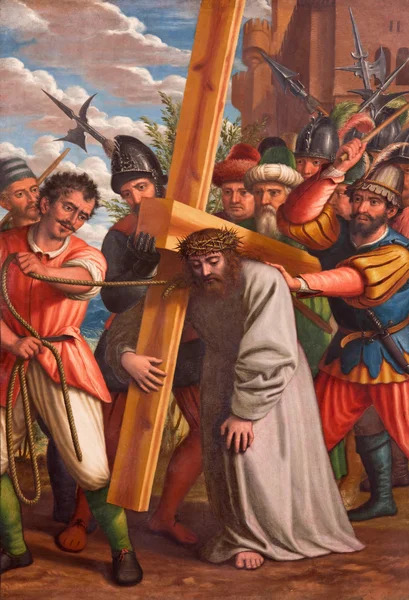
2nd Century AD:
Christian Spread:
During this century, Christianity continued to spread throughout the Roman Empire and beyond, despite periods of intense persecution. Christian communities emerged in major cities such as Rome, Antioch, and Alexandria.
Theological Development:
The 2nd century witnessed significant theological development. Early Church Fathers like Ignatius of Antioch and Justin Martyr contributed to theological discussions, defending Christian beliefs and engaging in debates with philosophers and religious leaders.
Emergence of Christian Texts:
The 2nd century also saw the emergence of various Christian texts. The Apostolic Fathers wrote letters and treatises that provided insights into the beliefs and practices of early Christians.
Also Read: The Book of Acts Timeline
Additionally, the New Testament Gospels (Matthew, Mark, Luke, and John) and Epistles (letters) began to circulate and were eventually recognized as authoritative Christian scripture.
3rd Century AD:
Continued Growth:
The 3rd century witnessed the continued growth of the Christian community. Notable conversions, such as that of Saint Helena, the mother of Emperor Constantine, helped elevate Christianity’s status within the Roman Empire.
Persecution:
Despite moments of relative peace, Christians still faced periods of intense persecution under various Roman emperors. Decius and Diocletian, in particular, initiated harsh persecutions that included the destruction of Christian texts and places of worship.
Theological Debates:
The 3rd century also saw theological debates and controversies within the Christian community. Disputes arose over the nature of Christ, with questions about his divinity and humanity. The authority of bishops and the structure of the Church were also subjects of discussion.
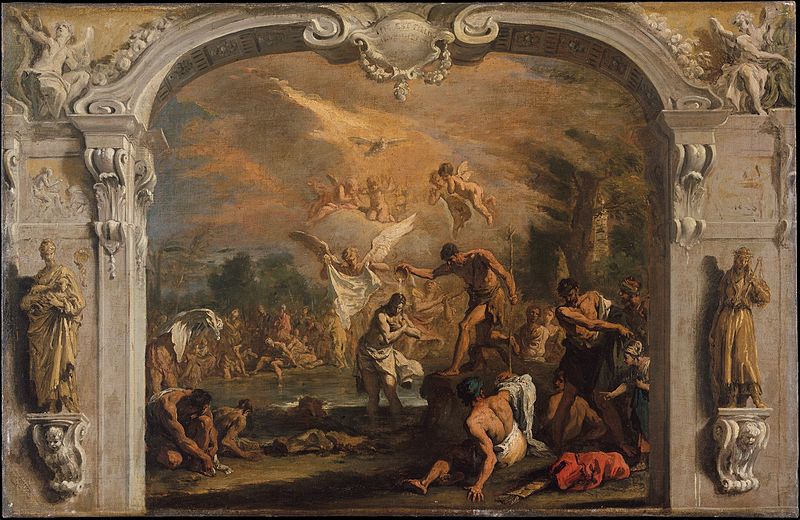
4th Century:
313 AD – The Edict of Milan:
One of the most significant events of the 4th century was the Edict of Milan in 313 AD, issued by Emperor Constantine and his co-emperor Licinius.
This edict granted religious tolerance to Christians within the Roman Empire, effectively ending the period of widespread persecution. Constantine’s conversion to Christianity and his support for the faith had a profound impact on the Church’s status and influence.
325 AD – The First Council of Nicaea:
In 325 AD, the First Council of Nicaea was convened by Emperor Constantine. This ecumenical council aimed to address theological disputes within the Christian community.
It resulted in the Nicene Creed, which established key Christian doctrines, including the divinity of Jesus Christ. The council also laid the groundwork for future ecumenical councils and the development of Christian orthodoxy.
Spread of Christianity:
The 4th century witnessed the rapid spread of Christianity throughout the Roman Empire. With Constantine’s support, Christianity became the favored religion, and churches were constructed in major cities. This period saw a transition from Christian communities meeting in homes to the construction of grand cathedrals and basilicas.
5th Century:
Expansion of Christianity in Europe:
During the 5th century, the influence of Christianity continued to expand in Europe. Missionaries played a crucial role in converting various European tribes, such as the Goths, Vandals, and Franks. These conversions had lasting effects on the religious and cultural landscape of Europe.
Development of Monasticism:
The 5th century saw the emergence of monasticism as a prominent aspect of Christian life. Monastic communities, like those founded by Saint Benedict, provided a structured and disciplined way of life for devout Christians seeking spiritual growth and withdrawal from worldly distractions.
Challenges and Conflicts:
This century was marked by theological disputes and conflicts within the Church. Controversies, such as the Nestorian and Pelagian controversies, led to the convening of ecumenical councils to address doctrinal issues and maintain theological unity.
6th Century:
Byzantine Empire:
In the Eastern Roman Empire (Byzantine Empire), Christianity played a central role in both the religious and political spheres. Theology and religious practice were closely intertwined with the Byzantine state.
Continued Monastic Growth:
Monasticism continued to flourish in the 6th century. Monasteries became centers of learning, preserving ancient texts and knowledge during turbulent times.
Conflict and Schisms:
Theological disputes persisted, leading to schisms and divisions within the Church. The schism between the Eastern Orthodox Church and the Western (Roman) Catholic Church began to take shape, with differences in theology and ecclesiastical authority becoming more pronounced.
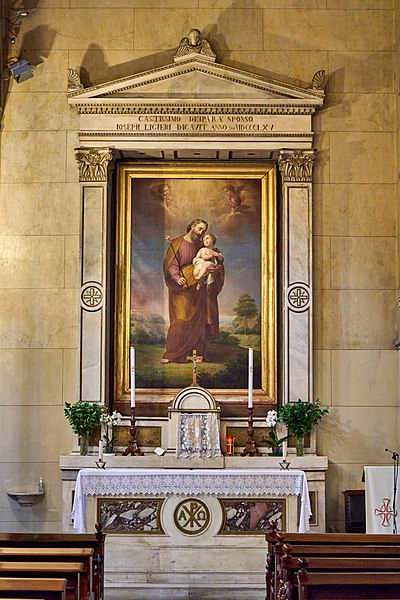
7th Century:
Byzantine Iconoclasm:
One of the significant theological controversies of the 7th century was the Byzantine Iconoclasm. This controversy centered on the use of religious icons (images) in Christian worship.
While it primarily affected the Eastern Orthodox Church, it had an impact on the wider Christian world.
The dispute over the veneration of icons eventually led to the Seventh Ecumenical Council (Second Council of Nicaea) in 787, which affirmed the use of icons in Christian worship.
Islam Emerges:
In the 7th century, Islam emerged in the Arabian Peninsula with the teachings of the Prophet Muhammad. The rise of Islam had a profound impact on the Christian world, particularly in regions where Islamic empires expanded.
Christian communities in areas such as the Middle East, North Africa, and Spain experienced significant changes in their status and relations with Muslim rulers.
Papal Authority:
The papacy in Rome continued to assert its authority during this period. Popes like Gregory the Great (Pope Gregory I) played crucial roles in strengthening the Church’s organization and influence, especially in Western Europe. Gregory is known for his missionary efforts and contributions to liturgy.
8th Century:
Charlemagne’s Coronation:
One of the key events of the 8th century was the coronation of Charlemagne as Holy Roman Emperor by Pope Leo III in 800 AD. This event marked the revival of the Western Roman Empire in the form of the Holy Roman Empire, with close ties to the Catholic Church.
Charlemagne’s reign had a profound impact on the relationship between secular and ecclesiastical authorities in Europe.
Carolingian Renaissance:
Charlemagne’s rule was associated with a revival of learning and culture, known as the Carolingian Renaissance. Monastic schools were established, and efforts were made to preserve and transmit classical knowledge and Christian theology.
The Iconoclastic Controversy Continues:
While the Seventh Ecumenical Council in 787 addressed the issue of iconoclasm, the controversy over the use of icons continued in the Eastern Byzantine Empire, leading to periods of iconoclastic policies and iconophile (pro-icon) movements. The final resolution of the iconoclastic controversy occurred in the 9th century.
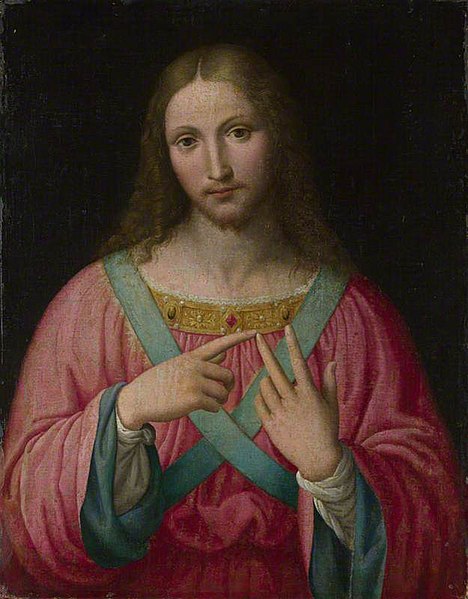
9th Century:
The Photian Schism:
The 9th century saw a major schism between the Eastern Orthodox Church and the Western (Roman) Catholic Church, known as the Photian Schism. It was rooted in disputes over the jurisdiction of the Ecumenical Patriarchate of Constantinople and issues related to ecclesiastical authority and doctrine.
Conversion of the Slavs:
Saints Cyril and Methodius, in the 9th century, were instrumental in the Christianization of the Slavic peoples. They developed the Cyrillic alphabet and translated religious texts into the Slavic language, which laid the foundation for the spread of Christianity in Eastern Europe.
Theological Developments:
Theological discussions and debates continued to shape the Church’s understanding of key doctrines, including the nature of Christ, the role of the sacraments, and the authority of the Pope.
10th Century:
Papal Authority:
The 10th century witnessed a continuing struggle for papal authority and influence. Popes sought to assert their spiritual and temporal authority, often clashing with secular rulers, particularly in the Holy Roman Empire.
The Great Schism:
A major schism occurred between the Eastern Orthodox Church and the Roman Catholic Church in 1054, known as the Great Schism. It was the result of longstanding theological, cultural, and political differences.
The mutual excommunications between the Patriarch of Constantinople and the Pope of Rome marked the formal split between the two branches of Christianity.
Monastic Reform:
Monastic reform movements, such as the Cluniac Reform and the Cistercian Reform, gained prominence during this century. These movements sought to address perceived corruption and laxity in monastic communities and played a role in revitalizing religious life in Western Europe.
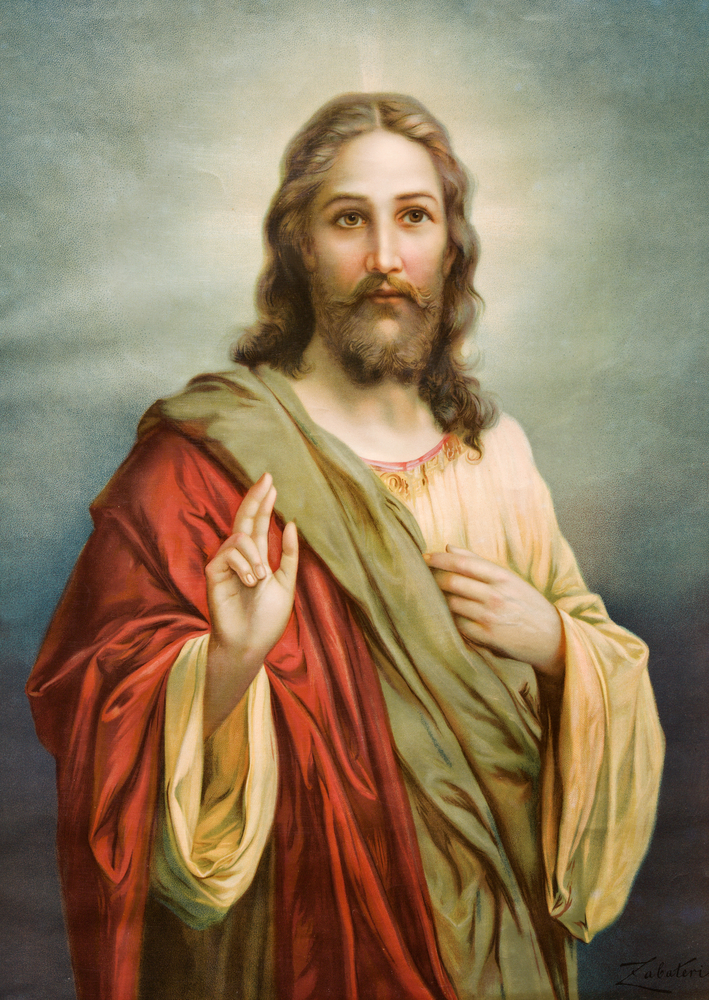
11th Century:
Investiture Controversy:
The 11th century was marked by the Investiture Controversy, a protracted conflict between the papacy and secular rulers, particularly the Holy Roman Emperors, over the appointment of bishops and the control of church property.
The conflict raised questions about the separation of church and state authority and led to compromises such as the Concordat of Worms in 1122.
First Crusade (1096-1099):
In response to a call by Pope Urban II, the First Crusade was launched with the goal of retaking the Holy Land from Muslim control. This military expedition had both religious and political motivations and resulted in the capture of Jerusalem by Christian forces.
Scholasticism:
The 11th century saw the emergence of Scholasticism, a philosophical and theological approach that sought to reconcile faith and reason. Prominent Scholastic thinkers like Anselm of Canterbury and Peter Abelard contributed to the intellectual life of the Church.
12th Century:
Second Crusade (1147-1149):
The 12th century witnessed the Second Crusade, which was called in response to the fall of the County of Edessa to Muslim forces. It was less successful than the First Crusade and faced significant challenges.
Cathedral Building:
The 12th century was characterized by the construction of grand cathedrals throughout Europe. These architectural marvels, such as Chartres Cathedral and Notre-Dame de Paris, served as centers of worship and cultural expression.
Founding of Religious Orders:
Several important religious orders were founded during this century, including the Templars, the Hospitallers, and the Premonstratensians. These orders played various roles in the Church, including military defense, care for the sick, and religious reform.
13th Century:
Thirteenth-Century Papacy:
The 13th century saw the papacy reach new heights of authority and influence. Popes like Innocent III exercised significant power and sought to assert papal supremacy over both secular rulers and the Church’s various jurisdictions.
Mendicant Orders:
The 13th century witnessed the flourishing of mendicant orders, such as the Franciscans and Dominicans. These orders, characterized by their vow of poverty and itinerant preaching, played a vital role in religious life, scholarship, and missionary activity.
Fourth Lateran Council (1215):
The Fourth Lateran Council, convened by Pope Innocent III, addressed various issues within the Church, including heresy and clerical discipline. It also affirmed the doctrine of transubstantiation, which holds that the bread and wine in the Eucharist become the actual body and blood of Christ.
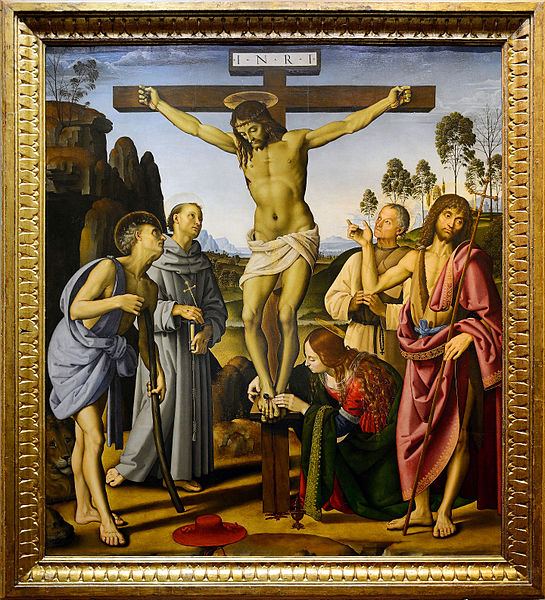
14th Century:
Avignon Papacy:
The 14th century was marked by the Avignon Papacy, during which several popes resided in Avignon, France, instead of Rome. This period led to tensions and confusion within the Church, as multiple claimants vied for the papal throne, ultimately culminating in the Western Schism.
Black Death:
The mid-14th century was also marked by the devastating Black Death pandemic, which had a profound impact on Europe and the Church. The Church’s response to the plague and its pastoral care for the afflicted played a significant role in the lives of medieval Europeans.
The Great Western Schism (1378-1417):
The Great Western Schism, also known as the Papal Schism, was a major crisis for the Catholic Church. It involved multiple claimants to the papacy, leading to confusion and division within the Church. The schism was ultimately resolved by the Council of Constance in 1417.
15th Century:
Renaissance Popes:
The 15th century saw the papacy take on a more humanistic character. Renaissance popes, such as Nicholas V and Julius II, were patrons of the arts and supported the Italian Renaissance. This period saw the commissioning of significant works of art and the construction of St. Peter’s Basilica in Rome.
Reform Movements:
Throughout the 15th century, there were various calls for reform within the Church, particularly in response to perceived corruption and moral laxity among clergy and the papacy. Figures like Jan Hus and John Wycliffe advocated for reform and questioned certain Church practices.
Fall of Constantinople (1453):
In 1453, Constantinople, the capital of the Byzantine Empire, fell to the Ottoman Turks. This event marked the end of the Byzantine Empire and had a profound impact on the Eastern Orthodox Church and its relationship with the Catholic Church.
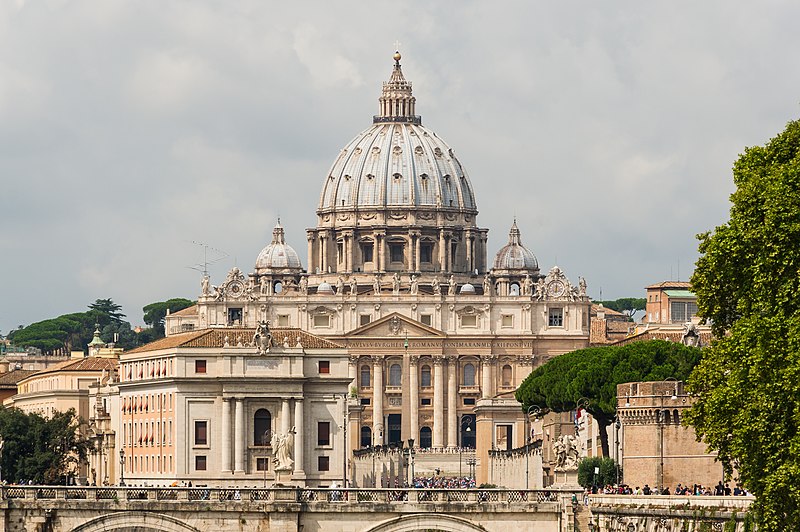
16th Century:
Protestant Reformation (Early 16th Century):
The 16th century began with the Protestant Reformation, which had a profound impact on the Catholic Church. Martin Luther’s Ninety-Five Theses in 1517 marked the beginning of this movement, which questioned the authority and practices of the Church.
The Reformation led to the fragmentation of Western Christianity into various Protestant denominations.
Council of Trent (1545-1563):
In response to the Protestant Reformation, the Catholic Church convened the Council of Trent, one of the most significant ecumenical councils in its history.
The council addressed doctrinal and disciplinary issues, reaffirmed Catholic teachings, and initiated various reforms, including those related to the education and training of clergy.
Catholic Counter-Reformation:
The Catholic Counter-Reformation, also known as the Catholic Revival, was a multifaceted response to the challenges posed by Protestantism. It included efforts to improve the education of clergy, enhance the spirituality of the laity, and combat heresy through the Inquisition.
Prominent figures like Ignatius of Loyola and Teresa of Ávila played key roles in revitalizing the spiritual life of the Church.
17th Century:
Expansion of Catholic Missions:
The 17th century saw the continued expansion of Catholic missions, particularly in Asia, the Americas, and Africa. Missionary orders like the Jesuits and Franciscans played pivotal roles in spreading Christianity to new regions.
Galileo Galilei:
The Church’s relationship with science came into focus in the 17th century with the trial of Galileo Galilei, a scientist who supported the heliocentric model of the solar system.
Galileo’s views were seen as challenging the Church’s interpretation of Scripture, leading to his condemnation by the Roman Catholic Inquisition.
Jansenism:
The Jansenist movement, rooted in the teachings of Cornelius Jansen, gained prominence in the 17th century. Jansenism emphasized strict adherence to predestination and original sin, leading to theological controversies within the Church.
18th Century:
Enlightenment and Secularism:
The 18th century was marked by the Enlightenment, an intellectual movement that promoted reason, science, and secularism. Enlightenment ideas challenged traditional religious authority, including that of the Catholic Church, in some European countries.
Suppression of Jesuits:
In 1773, Pope Clement XIV issued a papal brief suppressing the Society of Jesus, also known as the Jesuits, in response to political pressures and conflicts. The Jesuits were later restored in 1814 by Pope Pius VII.
French Revolution:
The French Revolution, which began in 1789, had a significant impact on the Catholic Church in France. The revolutionary government sought to diminish the Church’s influence, leading to the confiscation of Church property, the establishment of a state-controlled Church, and the persecution of clergy who refused to swear allegiance to the state.
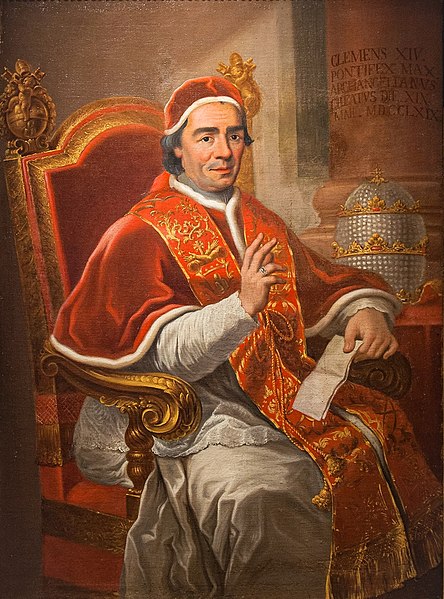
19th Century:
Napoleon and the Church:
The 19th century began with the aftermath of the French Revolution and the rise of Napoleon Bonaparte. Napoleon’s Concordat with the Vatican in 1801 reestablished relations between the French government and the Catholic Church. However, the relationship remained complex, with tensions between Church and state interests.
Papal States Dissolution:
In 1870, during the unification of Italy, the Papal States were dissolved, leading to the establishment of the Kingdom of Italy. Pope Pius IX’s loss of temporal power marked a significant change in the papacy’s political status, and the Vatican City was created as a sovereign entity within Rome.
Ultramontanism:
The 19th century also saw the rise of Ultramontanism, a movement that emphasized the authority of the Pope and centralized control of the Church. This movement played a role in shaping the papacy’s influence within the Church and its relationship with the faithful.
20th Century:
World Wars:
The Catholic Church played a significant role in the 20th century during times of conflict. During both World War I and World War II, the Church provided spiritual guidance and humanitarian aid, and some Church leaders actively worked to promote peace and protect persecuted populations.
Second Vatican Council (1962-1965):
The Second Vatican Council, often referred to as Vatican II, was a pivotal event in the 20th century. It sought to modernize the Catholic Church and address its relationship with the contemporary world.
The council introduced reforms, including changes to liturgy, greater emphasis on ecumenism, and a renewed focus on the role of the laity in the Church.
Social and Moral Issues:
The 20th century also saw the Church engage in social and moral issues, including debates on contraception (Humanae Vitae, 1968), abortion, and issues related to human rights, social justice, and the role of women in the Church.
21st Century (Up to 2021):
Papal Apologies:
In the 21st century, several popes have issued apologies for historical wrongs committed by the Church, including the Vatican’s apology for its role in the African slave trade and Pope Francis’ apology to indigenous peoples for historical injustices.
Sexual Abuse Scandals:
The Catholic Church has grappled with sexual abuse scandals involving clergy around the world. These revelations have led to significant efforts to address and prevent abuse, including changes in Church policies and greater transparency.
Interfaith Dialogue:
The Catholic Church has continued to engage in interfaith dialogue with other religious traditions, seeking to promote understanding and cooperation among different faith communities.
